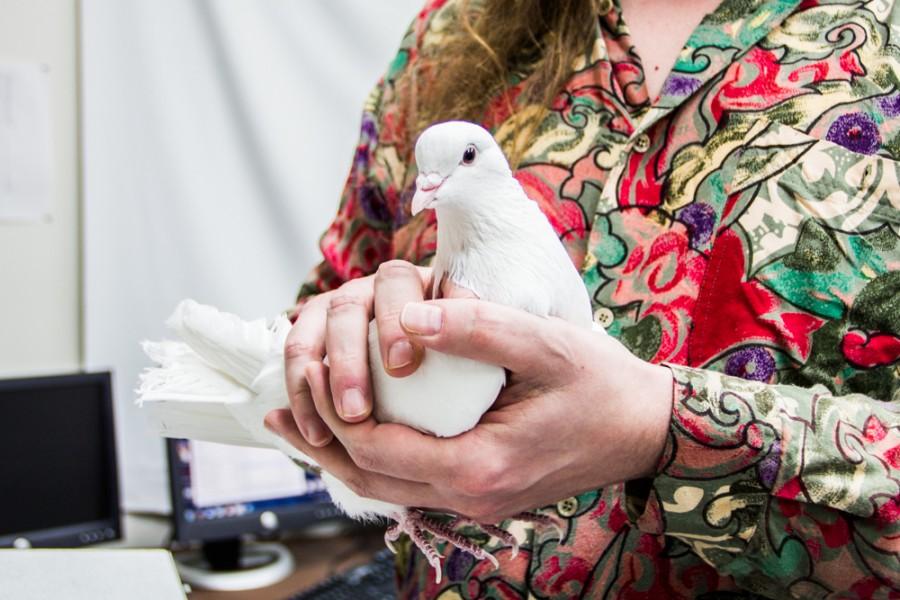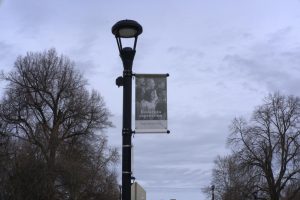Animal Minds
Whitman professors research animal brains to learn about humans. As the human-animal distinction blurs, so too does the ethical landscape.
February 25, 2016
There are some things at which a pigeon is better than you. For one, pigeons can fly. Second, pigeons are more adept at finding their way home. Also, pigeons are probably better at the old game show, Let’s Make a Deal, hosted by Monty Hall, than you are.
Say you are on the show, and the year is 1973 (the show, incidentally, has been restarted in recent years, with the esteemed Wayne Brady at the helm). Monty Hall is your host, the man with whom you will trade, the man whose conniving showbiz charm you will outwit to earn a car. Three closed doors appear before you. One, you know, has a car and the other two more have undesirables. You want this car. Door Number Three feels right. You select it and Monty Hall does you a solid, though you do not realize it. He, himself aware what lies behind each door, opens up Door Number One to reveal a goat! Door Number One is out.
Now Mr. Hall has a question: do you still want to go with Door Number Three? Yes you do. This is what you would probably say. When it comes down to it, all you’ve got is your gut, so you trust your gut. In any case it’s a fifty-fifty chance anyways, isn’t it? Why change?
It is a fifty-fifty chance, and this is precisely why, statistically, you should switch. When you make your initial guess, you have a one-in-three chance of selecting the car. When you make your second guess, one option has been eliminated, so your chance becomes one-in-two. You are more likely to select the car if you switch. This is true. Run a computer simulation if you don’t believe it. Or better yet, observe Professor of Psychology and Herbert & Pearl Ladley Endowed Chair of Cognitive Science Wally Herbranson’s laboratory pigeons, who a few years ago, “Outwitted the Whitties” in an experiment he created to simulate what has long been known as the “The Monty Hall Dilemma.”
The dilemma evokes the quantum. It doesn’t appear to make sense; why would the act of simply selecting another door increase your probability? You don’t get it because your brain is programmed in a way that makes “getting it” difficult. You must release your cognitive biases to get it.
“The way I look at it,” Herbranson said, “is that our suboptimality in solving the Monty Hall Dilemma is a consequence of some of the heuristics, some of the shortcuts that we acquire as part of our education process. We learn little tricks that allow us to come to a conclusion more quickly, such as, ‘Hey, if there are two doors left it’s gotta be a fifty-fifty proposition.’ Pigeons, on the other hand, are unencumbered by that kind of deep thought process. They just look at it as a probability learning task.”
In other words, pigeons learn through experience that changing doors simply works better. Most humans, even ones who complete the process hundreds of times, do not figure this out.
Herbranson’s Pigeons

These days, Herbranson’s pigeons, who spend their days in cages, or on scales, or in metal boxes pecking away at lights all on the third floor of the Maxey building, work on different tasks. Their current focus is attention. Herbranson, who has an impressive collection of groovy button-down shirts, compares pigeon attention to human attention. A popular experiment that has measured attention is this: an experimenter tells you to count the number of passes between people with black jerseys on a basketball court, and then, after you have completed this task she asks you if you saw the gorilla. There is a roughly fifty-percent chance that you will answer no, because in fact you did not notice the man in the gorilla suit who walked precisely into middle of the action and thumped his chest for a few seconds because you were too busy counting passes.
Wally gives his pigeons similar tasks. They stand in metal boxes, designed decades ago for pigeons (it’s unclear what makes them specifically pigeon-optimal). A display system consisting perhaps of differing colored patches or lines of varying orientations lies before them. Their task is to detect a change in color, a capacity they illustrate by pecking the changed display icon for which they receive pigeon-kibble.
Just as we are subject to change blindness (as illustrated by the gorilla experiment) this task becomes more difficult for pigeons when the timing, or another element of the display, is changed. For example, pigeons perform worse when the display turns off immediately before the change occurs.
Herbranson has been experimenting with different permutations on the theme for a few years now. He has introduced clues into the equation. Some pigeons have been working on this project for their whole lives, spending forty-five minutes in one of the boxes, five days a week. They gotta stay snappy, or they’ll forget the methodology.
The pigeons seem content with this life. They coo and ruffle around in their individual, nicely-stacked cages. The lab smells like a petting zoo. Some pigeons puff up real big when visitors enter the lab. It’s an attempt at intimidation presumably, but the tactic is rendered futile when Herbranson removes one from its cage and places it through a translucent matt, duct-taped into a cylinder (he made them himself), and its tiny white head protrudes stoically, and the puff of the rest of its body is morphed into a brief cylinder form while it is weighed, and walked through the hallway in the lab to its metal box, where it will do its important work.

Herbranson said that pigeons are great for his purposes.
“I’m a small lab in a small department in a small college,” he said. He serves the role of veterinarian and caretaker usually (though they have a vet on call). One pigeon has gauze wrapped around its neck such that it looks like the Warner Brothers’ Road Runner; it had been gnawing at itself too much. Herbranson compares the set-up to the dog’s cone of shame.
Herbranson said pigeons are more receptive to lab life than other birds. Most will live for ten or twelve years in the lab, almost twice that of their wild counterparts. He reckons they “live a pretty good life.” They are used over and over again. In the past, scientists were expected to use experimentally naive animals. That this is no longer true, he said, represents “a nice shift in the values of science. We value animal life a little bit more than we used to. If there are ways to minimize the number of animal subjects that we use, we are encouraged to do that.”
Ethics of Animal Research
Chris Wallace is the chair of Whitman College’s Institutional Animal Care and Use Committee (IACUC), which is composed of philosophers, bioethicists, psychologists (including Hebranson), community members, veterinarians and even, as of recently, an Environmental Health and Safety person. The committee, whose existence is mandated and overseen by the Federal Office of Laboratory Animal Welfare (OLAW), reviews all proposals for studies involving animal research at this school. Any study receiving federal funding must undergo review by such a committee. OLAW establishes guidelines and makes recommendations to the IACUC. “The idea,” said Wallace, “is that we really want to consider how necessary a kind of experiment might be.”
In recent decades, Wallace said that the sort of oversight provided by OLAW and IACUC has become “much more systematic and granular … Over the last 25 years there’s been an increased awareness, reflection and explicit commitment to animal welfare.”
There is a growing awareness that humans are not fundamentally categorically different from everything else. We are physical stuff just like rocks, and wind, and horses and redwood trees. What this means, said Wallace, “is that culturally we’re much more attuned to the place of humans in the planet, and how the footprint of mankind treads on other life forms…I think we’ve gotten–and I’m delighted about this–much more in tune with planet ecology, and I think part of that is realizing that we are one species among many.”
What is the value of a life? What is the value of the research we do on a life? What is the value of the lives of animals relative to one another? What does mental capacity have to do with it? Wallace suspects that Whitman students may fall all across the spectrum on these sorts of questions.

A good deal of research is currently being done on the inner, psychological lives of animals. An essay in the “New York Review of Books” pulls a passage on elephants from Carl Safina’s “Beyond Words”: “Their great breaths, rushing in and out, resonant in the halls of their lungs. The skin as they moved, wrinkled with time and wear, batiked with the walk of ages, as if they lived within the creased maps of the lives they’d traveled.” There is a richness to such descriptions. These elephants are stationed on no lower a plane than us. The review, which is by Tim Flannery, also looks at Safina’s discussion of the neurotransmitters–serotonin, oxytocin–that dictate our own inner lives. These chemical messengers are ubiquitous throughout nature. On one hand, it is vanity to anthropomorphize while on the other, to do so is a respectful acknowledgement of the depths of feeling beyond the bounds of the Homo Sapien.
Wallace notes a blog post by Ingrid Newkirk, the president and founder of Peoples for the Ethical Treatment of Animals (PETA) entitled “A Rat is a Dog is a Pig is a Boy” (PETA is staunchly against all forms of animal research). Wallace also notes that all of the animals listed in this blog are vertebrates. Is that where you draw the line?
Implications of Animal Research
We study animals because we understand that they are of the same kind as us. Herbranson said that, “If we really want to understand learning, attention…[and] memory, we’re not particularly well-served by just studying those in humans.” Wallace, who often teaches the classic Biology 111 fetal pig dissection lab, will sometimes describe the pig to students as “an avatar”–here he laughs–“to get inside themselves.” The department has a “virtual pig” (“really nice detail so you can see the landscape”) for those who are uncomfortable with the idea of dissecting a real one, but Wallace really recommends that students just do it. “If you look at the benefits of animal research,” he said, “they begin with insight into how things actually work. So the idea of replacing investigation of living organism with a model–in a way it’s like Semester in the West, stay-at-home version on CD’s.”
“I really encourage students to do two things,” he continued. “One is to take seriously animal welfare, to have a reverence for the organism, as well as to try and appreciate the beauty and reality of the anatomy and physiology. I think every student needs to make a choice in that regard. I would encourage students to look at real physiology the way I would encourage them to read primary texts, and actually go visit places…I think there’s something kind of irreplaceable about direct observations.”
Wallace, who is a neuroscientist himself, is currently studying rats in what he terms “the college stage” of their development. They are just starting to develop social skills; they play with one another and explore. Wallace places them in complex environments and studies the development of their brain cells. The research is confirming the importance of environment in upbringing. “I see my rats changing actively in response to experience in ways that I believe my young infant son did and I did before him,” he said. “I think what we’re seeing is a kinship. That’s what makes the model relevant to our understanding, but again I think part of that kinship is caring about the life of the animal.”








